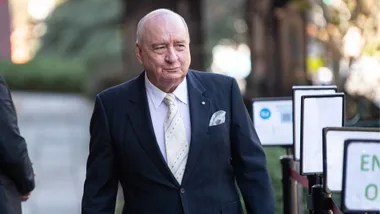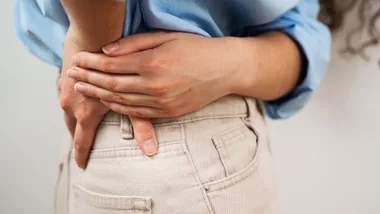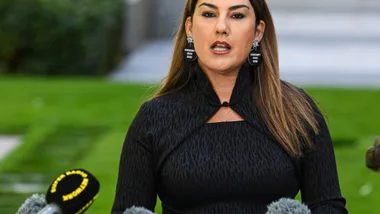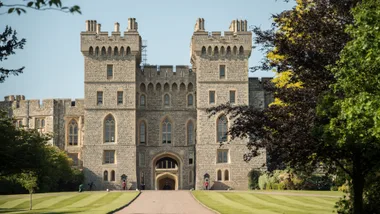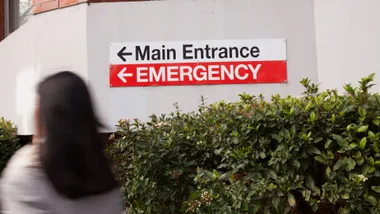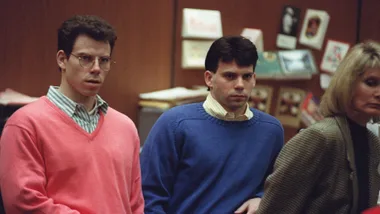When a catastrophic ammonium nitrate explosion ripped through Beirut on August 4, it killed more than 200 people, wounded thousands of others and left 300,000 displaced. Sarah Ayoub talks to the women on the frontline about the anguish, the aftermath and, now, the recovery effort.
The Nurse
Pamela Zeinoun was working her shift at Saint George Hospital University Medical Center at the time of the blast. As her colleagues lay injured around her, she rescued three premature babies and walked five kilometres to another hospital with them in her arms.
Pamela Zeinoun was a few days shy of her 26th birthday. She remembers the floor shaking beneath her feet at the Paediatric and Neonatal Intensive Care Unit where she had been working since graduating from university five years earlier. Buried under rubble, glass and metal shelves, and with her colleagues motionless and bleeding around her, Zeinoun realised the incubators that had housed the unit’s three premature babies—15 to 20 days old—had shifted from their positions upon impact, and forced herself to act.
“Everything was destroyed,” she recalls. “I had rubble above me, next to me, on the floor. I wasn’t able [to move] at first because there was a bit of weight on me, but I thought that these babies needed someone, so I just got myself up and ran towards them.”
Zeinoun was relieved to find none of the babies—who were born at 30 weeks and weighed less than two kilograms each—had been injured despite their fragile bodies. “One of them was crying when I reached him, but the two girls were safe and asleep,” she says. “I just grabbed them and ran. But I was very scared, because I still did not know what was happening.”
With nearby hospitals destroyed, Zeinoun walked towards Hôpital Aboujaoudé, about seven kilometres from where she works, shocked at the devastation around her. She had about two kilometres left to travel when a family saw her on the street and drove her the rest of the way. The parents of the babies eventually found them at the second hospital, in a reunion she says was incredibly moving. It was only after visiting the infants in their homes a week later that Zeinoun was satisfied they were really OK. “I calmed down when I saw the babies with their parents a week after the blast,” she says. “Their parents were very welcoming and said they would forever be grateful for what I did for their babies. It was very emotional.”
In the days after the blast, the image of Zeinoun holding three tiny babies went viral around the world, and she was praised as a hero. But while she’s appreciative of all the love and support she’s received, she is adamant that giving help is intrinsic to her people. She is surprised at the strength she has drawn from her experience in the blast, and from the solidarity displayed by her fellow citizens, both in and out of Lebanon.
“What I did was my duty,” she says. “[Now] I feel happy and proud when I see Lebanese people from all around the world showing support for [us] and the situation we’re passing through. This has made me forget the pain of the blast.”
The Bride
US-based doctor Israa Seblani was filming her wedding video near Beirut’s port when the explosion put an end to her big day. She sought shelter in a nearby restaurant with her new husband, where she tended to the injured in her wedding dress.
Having postponed her wedding for almost three years as a result of the Beirut street protests, COVID-19 travel restrictions and the delay on her husband Ahmad Subeih’s visa approval to the US, Dr Israa Seblani felt like she was taking on the world when she flew back to Lebanon, where she had grown up, to tie the knot during the busy Lebanese summer.
When her big day finally came, Seblani felt like a princess. With her posy of flowers perched delicately beside her on the veil framing her lace hijab in her Beirut photoshoot, she looked every inch the radiant bride as she posed outside the Le Grey hotel, where she was to spend her first night as a married woman.
But her joy was short-lived, and dramatic footage by her wedding videographer captured the precise moment that the explosion ripped through the city, dragging Seblani—convinced she was going to die—across the pavement with its force.
“My dreams and the things we wanted to do together were flying as the shattered glass was flying,” she said in an interview following the blast. “I asked God for one thing: a moment or a second to hold my parents’ hands and tell them goodbye.”
Instead of dwelling on what was lost—the joy of the day that she had been looking forward to, the celebration and dancing that is intrinsic to Lebanese wedding parties—Seblani focused on her calling. “The lab coat is white, my dress is white,” she rationalised as she set about tending to the wounded in a nearby restaurant where she and her groom had sought shelter.
“[People were] shouting, crying, yelling and bleeding, so I started to help, telling them to relax, that we will be fine,” she told The Washington Post. “I was like, ‘Israa, your job starts here, you should go for it.’ I couldn’t think about myself anymore. I chose to be a doctor just for one thing: to help people, to offer something to the world, anything I could possibly offer.”
Running on adrenaline and survival instinct, Seblani was comforted by the smiles, prayers and gratitude of those she helped on the day, but waking up the next morning, she mourned for her nation. “I feel so sad about what happened to other people, about what happened to Lebanon. There is a lot of damage, many people were killed and wounded,” she told Reuters. “But also if I want to look at us—myself, my husband, the photographer—how we escaped unharmed, I thank God for protecting us. This alone makes me feel optimistic and to keep the joy of the occasion that I came here to celebrate.”
The Rebuilders
Traumatised by the destruction in their beloved city, Mariana Wehbe, a PR executive, and Nancy Gabriel, a gallery co-founder, established a movement to restore doors and windows to Beirut homes.
Mariana Wehbe had just left a meeting and stepped into the corridor to call her daughter when the explosion hit, a split-second decision that she says spared her being sliced by the glass that showered her workplace. Not far from Wehbe’s office, Nancy Gabriel was at home with her children on the 27th floor of their building, their 4.5-metre facade of glass windows offering a sweeping view of the fire preceding the explosion. At the first billows of smoke, Gabriel instinctively pulled her children away to a stairwell, which spared their lives as their entire home was destroyed around them. When Gabriel went to stay at her friend Wehbe’s house, they realised what needed to be done and set about establishing Beb w’ Shebbek—which translates to “door and window”—to repair people’s homes, recruiting everyone they knew to help. “We launched an Instagram page, started creating teams of two to three people [to go into people’s homes] and now we have our full mission, an office and 150 people on board,” Wehbe explains.
With support from NGO Unite Lebanon Youth Project, which established a special relief fund for their initiative, the two have set up an impressive model, with dozens of deployed groups on the ground, heads of teams conducting assessments, and Google sheets itemising details, images, measurements and quotes, split by areas and locations. “We work day and night,” says Wehbe. “I am on my phone all day with groups, volunteers and contractors. Nancy takes care of all the procurement coming from abroad. At some point this will have to move into manufacturing [because] this could take two or three years.”
The duo have their work cut out for them: approximately 80,000 homes have been destroyed, and even though they source at least two quotes per repair, their work is looking costly, with a single door costing the project between $US400 and $800. These issues are compounded by COVID-19—the women insist their volunteers maintain social distancing even inside people’s homes—and the country’s economic collapse, which has seen suppliers looking abroad because banks aren’t giving people their money. But even with their aim of repairing at least 3000 homes—at a budget well into the millions—they are not deterred, feeling a profound responsibility to use their contacts and resources to rebuild their country.
They’re also adamant that their project preserves the integrity of their city in all its diversity. “We want to preserve the history of these neighbourhoods, we want our kids to see [Beirut] for what it was,” says Wehbe.
Gabriel hopes their attempts at restoration will bring back some sense of normalcy to their communities, whose memories and daily habits disappeared when their favourite bars, restaurants and boutiques were lost. “It’s very easy to turn my back and take my family elsewhere,” she says. “We’re trying, through this initiative, to heal our community because the destruction is so massive that it will always visually remind us of our trauma, and we will never heal if we don’t erase the consequence of what happened and have our beautiful city back.”
To donate to Beb w’ Shebbek, visit ulyp.org/donate.
The Activist
Oleksandra El Zahran has used her Instagram account, @polleksandra, to call attention to Lebanon’s increasingly turbulent political situation and economic struggles. In the aftermath of the blast in the city of 361,000, she called out the government’s use of violence to quell the protests of frustrated youth and its refusal to tend to its grieving citizens.
Oleksandra El Zahran is still emotional when she thinks about August 4, the day her city crumbled around her. She was exercising outside, about four kilometres from the port, when the explosion knocked her to the ground, covering her in shards of glass. Later, when her mother rang from the Ukraine to check on her, the young activist recalls muting her phone so her sobbing wouldn’t be heard. Despite injuring her leg in the explosion, El Zahran didn’t seek medical treatment the traditional way. High on adrenaline, she first went to donate blood, then asked a medical student in a WhatsApp group for help so she wouldn’t clog the hospital system. For El Zahran, who has amassed 86,000 Instagram followers by speaking out about her country’s lack of infrastructure and the way women are treated under Lebanese laws, social media has been a vital tool for wrangling resources and drawing attention to the dire situation.
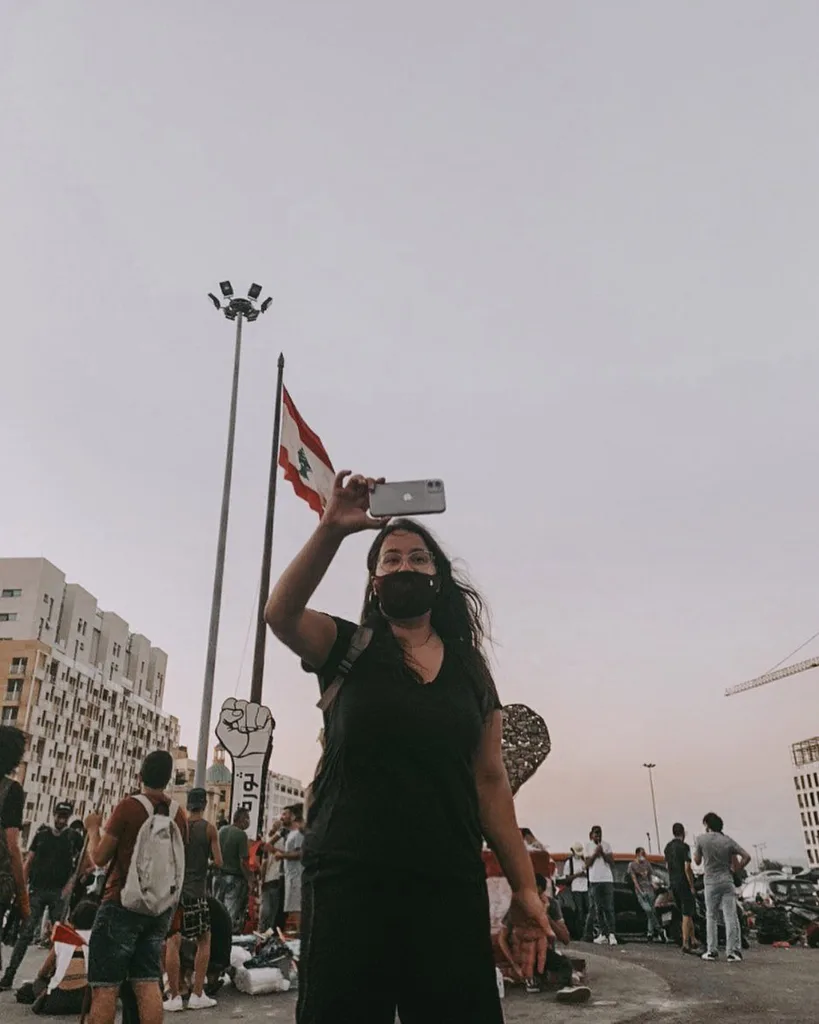
El Zahran is understandably livid that her government’s negligence – it had been repeatedly warned that storing such large amounts of ammonium nitrate would be catastrophic – has once again torn apart her nation and is even more enraged at its failure to engage with people’s grief, noting that it has been expats and people around the world who have to come to Lebanon’s aid. “[First it was] no money, no water, no electricity, but now they have actually killed their people,” she says. “And we will never forget and forgive the murderers of Beirut. They can threaten us and oppress us but they won’t break us. There is nothing else for us to lose.”
Before the blast, El Zahran was on the frontline of the country’s 2019 thawra, or revolution, determined to oust a government that has repeatedly failed to tend to the basic needs of its people. She used her Instagram account to share stories and information from around the country. “At that point social media was doing a faster job than news channels during the thawra. If someone got attacked [or] teargas was used, I would post it on my page,” she says.
Once again, El Zahran has logged on in the aftermath of the explosion, using her account to mobilise support to help communities in need: collecting toys and colouring equipment for children in damaged neighbourhoods; publicising a resident’s need for a medicine, which an expat sent over; collecting money to repair someone’s house.
El Zahran hopes the unity displayed in the aftermath of the explosion carries into concrete change for her nation. “Once we adapt we will lose the battle,” she says. “We need to [elect] people who have a plan to rescue Lebanon. [Actually] there is nothing to rescue, it’s rebuilding the system and the country from zero.”
This article originally appeared in the November 2020 issue of marie claire Australia.



